This article has been reviewed according to Science X's editorial process and policies. Editors have highlighted the following attributes while ensuring the content's credibility:
fact-checked
trusted source
proofread
New study shows similarities and differences in human and insect vision formation

Researchers at the University of California, Irvine have discovered profound similarities and surprising differences between humans and insects in the production of the critical light-absorbing molecule of the retina, 11-cis-retinal, also known as the "visual chromophore." The findings deepen understanding of how mutations in the RPE65 enzyme cause retinal diseases, especially Leber congenital amaurosis, a devastating childhood blinding disease.
For the study, recently published in the journal Nature Chemical Biology, the team used X-ray crystallography to study NinaB, a protein found in insects that functions similarly to the RPE65 protein found in humans. Both are crucial for synthesis of 11-cis-retinal, and their absence results in severe visual impairment.
"Our study challenges traditional assumptions about the similarities and differences of human and insect vision," said corresponding author Philip Kiser, UCI associate professor of physiology & biophysics as well as ophthalmology. "While these enzymes share a common evolutionary origin and three-dimensional architecture, we found that the process by which they produce 11-cis-retinal is distinct."
Creation of 11-cis-retinal begins with the consumption of foods like carrots or pumpkins containing compounds used for vitamin A generation, such as beta-carotene. These nutrients are metabolized by carotenoid cleavage enzymes, including NinaB and RPE65.
It was previously known that humans require two of these enzymes to produce 11-cis-retinal from beta-carotene, whereas insects can achieve the conversion with just NinaB. Gaining insight into how NinaB can couple the two steps into a single reaction along with the functional relationships between NinaB and RPE65 was a key motivation for the study.
"We found that structurally, these enzymes are very much alike, but the locations in which they perform their activity are different," said lead author Yasmeen Solano, a graduate student in Kiser's laboratory at the UCI Center for Translational Vision Research.
"Understanding key features within the NinaB structure has led to an enhanced understanding of the catalytic machinery necessary to support the function of the retinal visual pigments. Through our study of NinaB, we were able to learn about the structure of a key portion of RPE65 that had not previously been resolved. This discovery is vital in understanding and addressing loss-of-function mutations in RPE65."
Other team members included Michael Everett, a junior specialist in the Kiser lab, and Kelly Dang and Jude Abueg, biological sciences undergraduates at the time.
More information: Yasmeen J. Solano et al, Carotenoid cleavage enzymes evolved convergently to generate the visual chromophore, Nature Chemical Biology (2024). DOI: 10.1038/s41589-024-01554-z
Provided by University of California, Irvine





















